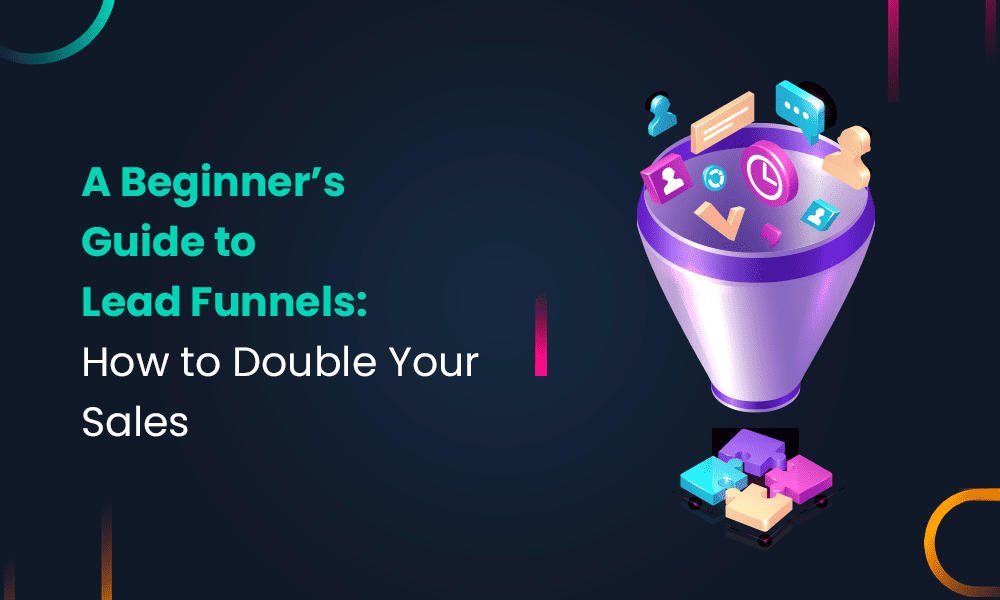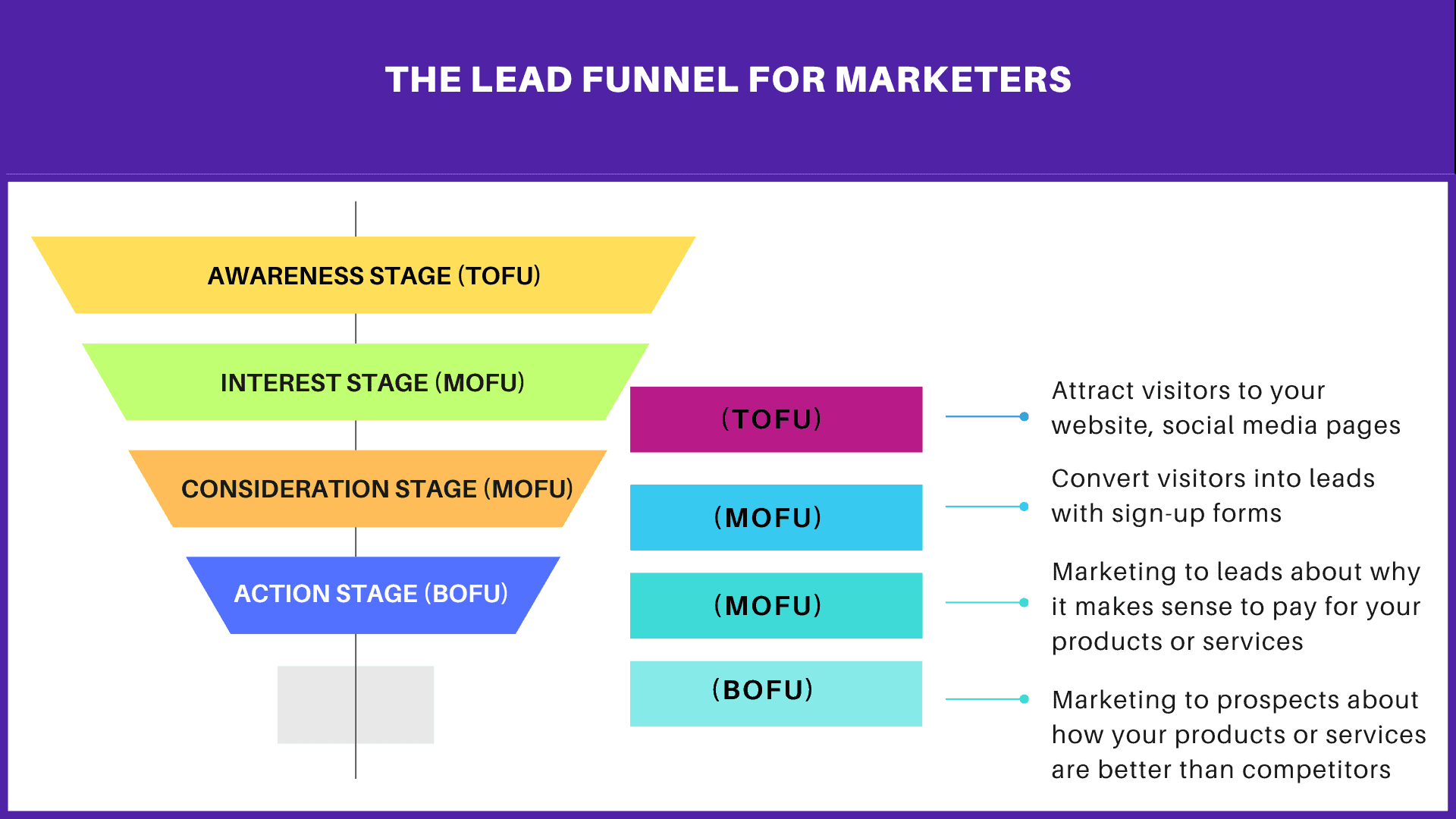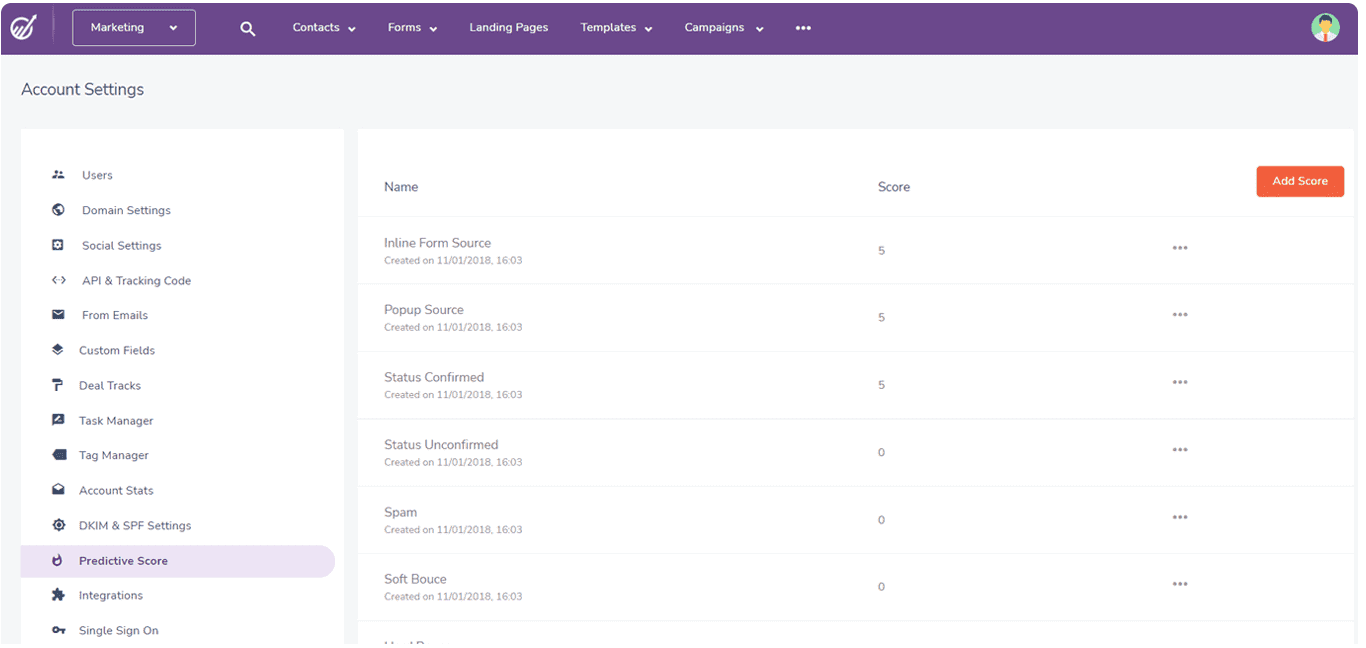It’s no secret that many small businesses took a significant hit during the pandemic. In 2023, companies will need a solid lead-generating strategy to tide over the shaky economy. This is where a lead funnel comes in.
According to a recent survey, 61% of marketers said lead generation was the single biggest challenge in 2022.
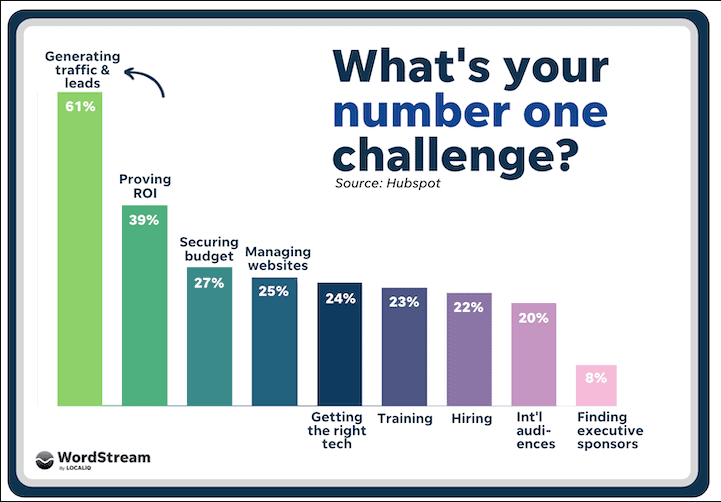
That’s why we’ve made this definitive guide on everything you need to know about lead generation funnels. We’ll dive deep into:
- What is a lead funnel and why it’s important
- The four stages of a lead funnel
- A simple 6-step process to build your lead generation funnel
- Simple lead funnel tips to double your sales
- An overview of the best lead generation tools (with pricing)
Table of Contents
Lead Funnel 101: A Definition
A lead funnel is a visual representation of each step your leads need to move through before they make a purchase. It begins when a customer first becomes aware of your brand or product and ends with them becoming a paying customer.
The main goal is to attract more prospects through inbound marketing, getting them to opt-in to your list, and eventually selling your product to them.
Each business creates its own lead funnel based on its requirements. But, usually, customers move through these four stages of the lead funnel.
The lead generation process in digital marketing is pretty similar to farming! How?
Well, think of each lead as a seed that will harvest profits in the future. For a good harvest, you need the right kind of seed based on how much land and resources you have.
Once you get the seed, then it takes time before the seed is ready to sprout. You’ll need to water them and keep pests away.

In the same way, you need to focus on quality leads for your business, depending on your goals and resources. Once you find the right lead, you’ll need to warm them up and move them through different stages at the right time.
What’s the difference between a sales funnel and a lead funnel?
It’s pretty easy to get these two concepts confused. Let’s clear it right up.
The only similarity between a sales funnel and a lead funnel is that both aim at nudging a prospect closer to making a purchase.
But, lead funnels only have brand-new leads who have never purchased from your company.
A sales funnel caters to all types of leads — whether they are returning customers or new ones. A sales funnel typically has a broader scope and utility. Each company uses these funnels to leverage customer action at the right time.
Sales Pipeline vs Sales Funnel — Yes, They’re Two Different Things
Why is a Lead Funnel Important for Your Business?
Now that you know what a lead generation funnel is, let’s see why it is crucial for your marketing success. Remember that both B2B and B2C companies benefit from a great lead funnel.
- Generating more leads: You’ll have a clear game plan to attract more leads to your inbound marketing channels. This means you’ll generate more leads, especially if you feature quality content.
- Focusing on quality leads: Not all leads are equal. You’ll be able to segment and target the right leads who are likely to make a purchase.
- Easier lead generation automation: Once you have pre-defined steps and processes, automating your lead generation process becomes easier. This saves time and improves your ROI in the long run.
- Improving conversion rates: When your sales and marketing teams are in sync about the prospect’s next steps, your conversion rates will also improve.
- Providing top-notch customer experience: When your lead generation process is streamlined and uniform, you’ll provide a world-class customer experience.
- Better lead nurturing process: You’ll get a clearer understanding of how to nurture each new lead, based on their demography, interests, and past behavior.
eCommerce Sales Funnels 101: A Beginner’s Guide
Lead Funnels in Marketing: The 4 Key Stages
There are four primary stages of a lead funnel. Understanding the purpose and actions for each step of the funnel will help you fully leverage each stage.
The bottom line is that you cannot market the same messages for different funnel stages. Don’t fret if you’re new to this. We’ve got you a complete breakdown of the 4 stages. Some companies use the qualification stage as their fifth stage.
At each stage, we’ll look at the example of a hypothetical prospect named Jane as she moves through different stages.
1. The Awareness Stage (TOFU)
This is the first stage through which your new prospect enters this funnel. It’s commonly called the top-of-the-funnel stage or TOFU in short.
At this stage, your prospect has become aware of your brand and products. Your website will be crucial at this stage of the buyer’s journey. A simple step like adding a sign-up form on your home page can help.
Let’s assume you’re a company that sells excellent gut health supplements. At this stage, your hypothetical prospect Jane has run a Google search about gut health supplements and their possible side effects. And, she stumbles your authoritative blog about prebiotics.
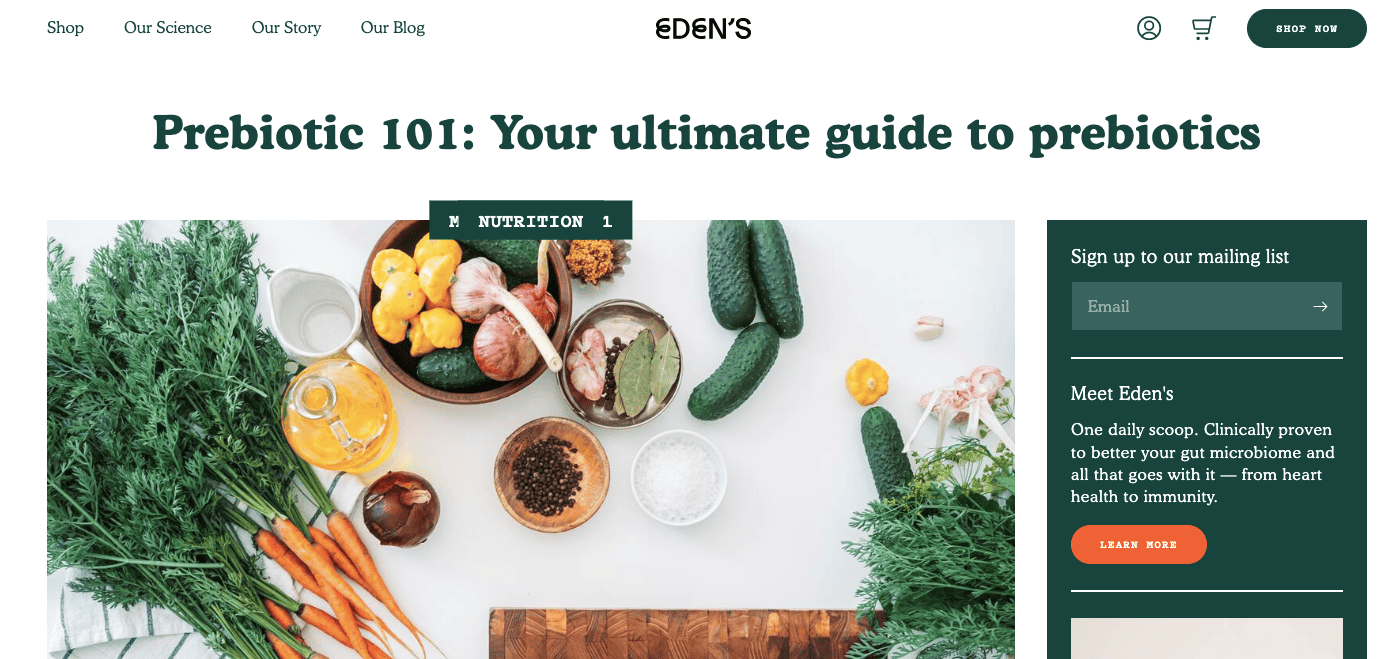
At this stage, Jane has begun to trust your company as she was able to find accurate and helpful information on your website.
Marketing goals for the awareness stage
At this stage, the major goal is creating excellent content that highlights the perceived value of your products.
And, you’ll need to start building trust with your prospects at this stage. Your goal is also to attract the maximum number of prospects to get them started on the lead funnel.
All your efforts for this stage should be geared towards engaging the customers, getting them to sign up for your email list, and giving them quality content about your products and market niche.
A lead magnet can work wonders for you to meet your awareness stage marketing goals, and drive the prospect into the next stage of the funnel.
Read also: eCommerce Email Conversion Funnel Analysis Guide For Beginners
2. The Interest Stage (MOFU)
In the interest stage of the lead generation funnel, your prospect has now become interested in your product or solution. At this stage, they are not ready to make the purchase yet. They may still be considering alternatives to your brand at this stage.
So, it becomes crucial to nurture your leads who are at this stage of the lead funnel.
Let’s go back to Jane, who is now at this stage of the lead funnel. Jane has browsed through a few more relevant blogs and browsed through products that are suited for her.
At this stage, she sees the following squeeze page and decides to sign up after seeing the 10% discount on her first order.
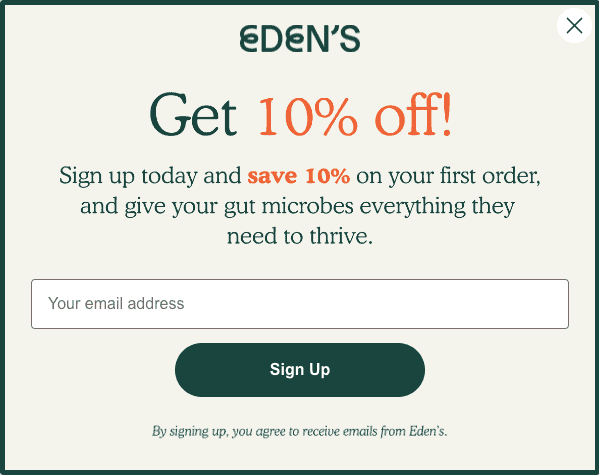
Marketing goals for the interest stage
The major marketing goal at this stage is to provide accurate, educational information about your product and the problems it can solve for your prospect.
This can include a strategy of starting an email nurturing campaign, sending curated blog posts based on their interest, and video explainers and infographics.
Your goal at this stage is to move the prospect to the consideration stage of the lead funnel.
Read more: eCommerce Conversion Funnel in 5 Stages
3. The Consideration Stage (MOFU)
At the consideration stage of the lead funnel, the prospect zones in on their specific problem and tries to find the most suitable product for their situation.
At this stage, they are weighing their options. Here too, they’re not yet ready to buy your product.
This is one of the longest stages in the lead funnel, so don’t get disheartened at this stage. Every lead wants to find the most efficient solution to their problems.
Coming back to our prospect — Jane. At this stage, she is looking into the side effects, benefits, and costs of several gut health products. She might also consult her physician for advice.
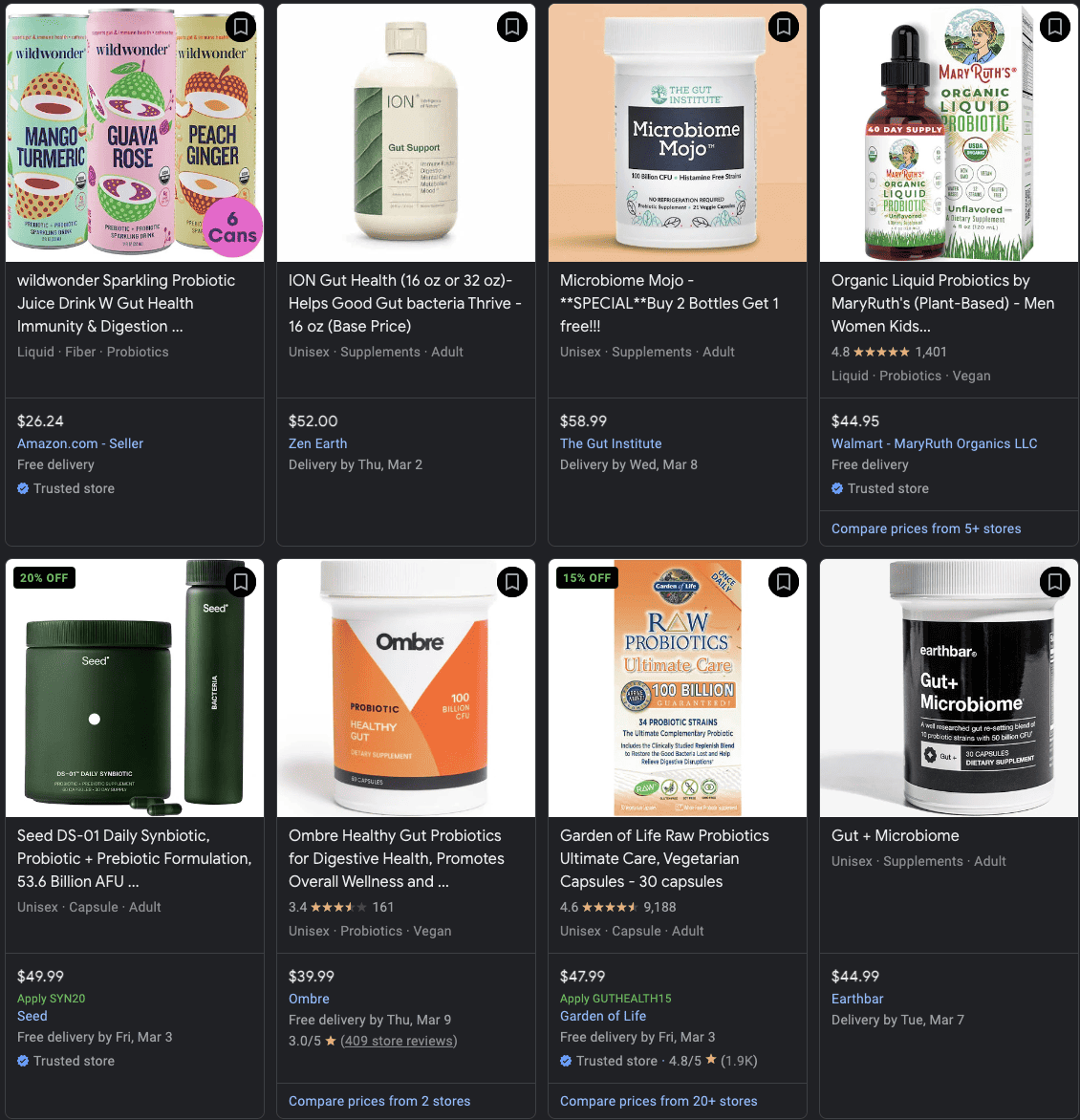
Marketing goals for the consideration stage
At the consideration stage, your marketing goal is to showcase how your product stands out from the competition and build trust with your prospects.
The consideration stage is a great opportunity to re-engage inactive leads by showcasing why your product can solve their problem better than others.
3. The Action Stage (BOFU)
The action or decision stage of the lead generation funnel is when your qualified lead decides to take action toward making a purchase.
If a prospect has reached this stage, they are not just browsing casually. And, this is good news for you.
At this stage, they have already weighed their options and are likely to buy your product. But, often, they need a gentle nudge to close the deal.
Jane, at this stage of the lead funnel, has received the following email in her inbox. She feels she has enough data to make an informed decision about her gut health supplement.

Then, she looks through several five-star reviews. Finally, she remembers having a code to get 10% off on her first order.
This prompts her to choose Eden’s over other competitors. With this purchase, she moves to the last stage of the marketing funnel.
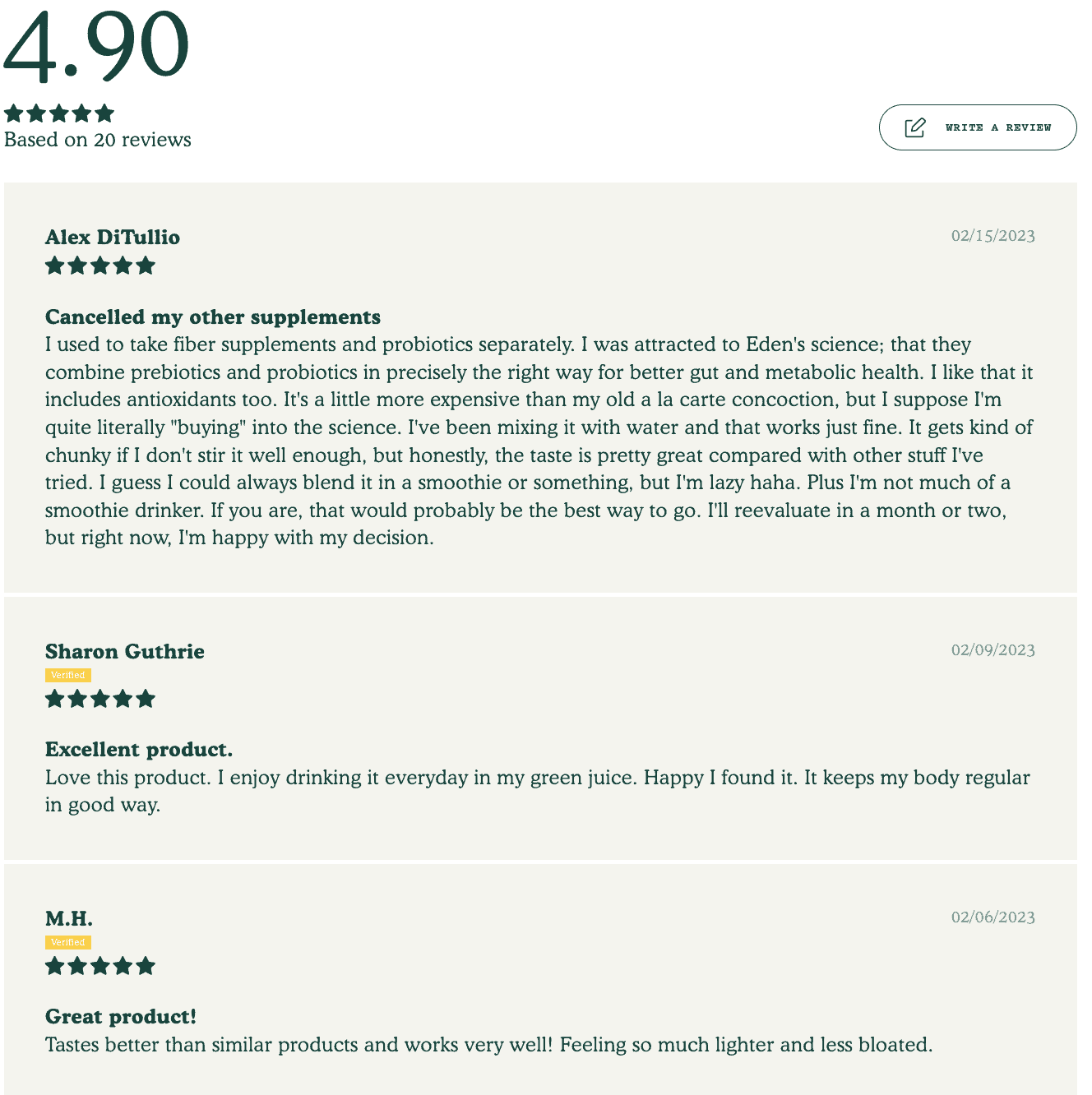
Marketing goals for the decision stage
At the decision stage, your marketing goal is to provide valuable content directly related to your product.
Your decision-stage marketing content should convince the prospect why your solution is the best fit for them without it devolving into a sales pitch. At this stage, you can also consider sending cart abandonment reminders, limited-time offers or discounts, or a discount for first-time buyers.
Once a customer has made a purchase, they can be moved to the “loyalty stage” of the marketing funnel. At the final stage, you can engage loyal customers with loyalty programs, reviews, and surveys.
Now that you have a clear idea of the stages of a lead funnel, let’s look at how you can build one for your company.
Lead Scoring Software For Free: EngageBay CRM
6 Steps to Build a Solid Lead Funnel
Here are seven simple, yet proven steps to build a solid lead generation funnel for your business. The actual funnel will vary based on touchpoints, but this can be a helpful template to get started.
1. Create accurate buyer personas and map key touchpoints
A buyer persona is nothing but a semi-fictionalized profile of your ideal customers and their characteristics. It’s a detailed answer to the question – who would be most interested in your product and why?
According to studies, 71% of high-performing companies use buyer personas to surpass their revenue target!
Whether you are a B2B or a B2C company, there are no pre-designed personas you can just download and use. Typically, based on the business size, companies use between 2-20 buyer personas.
Start with extensive market research and customer surveys as you build your buyer personas. Here’s a sample 👇🏻

And, you can also create ‘negative personas’. This is the type of lead you will not be targeting. For example, the lead could be too advanced to need your product, or they could be a student who is merely reading your blog for information.
This way, you’ll be sure to spend your marketing efforts only on qualified leads. Based on your research and basic demographic information, you’ll be able to build buyer personas that are perfect for your lead funnel.
Once this is done, the next step is to map all your touchpoints for each stage of the lead funnel.
A customer touchpoint refers to a point of contact between your brand and your prospect. For example, if someone clicked on a paid Facebook ad, this is a touchpoint at the awareness stage of the lead funnel. If a prospect contacts you for a demo or a sample, then it’s a touchpoint at the consideration stage of the lead funnel.
The image below highlights standard customer touchpoints, but actual touchpoints will vary based on your marketing channels.
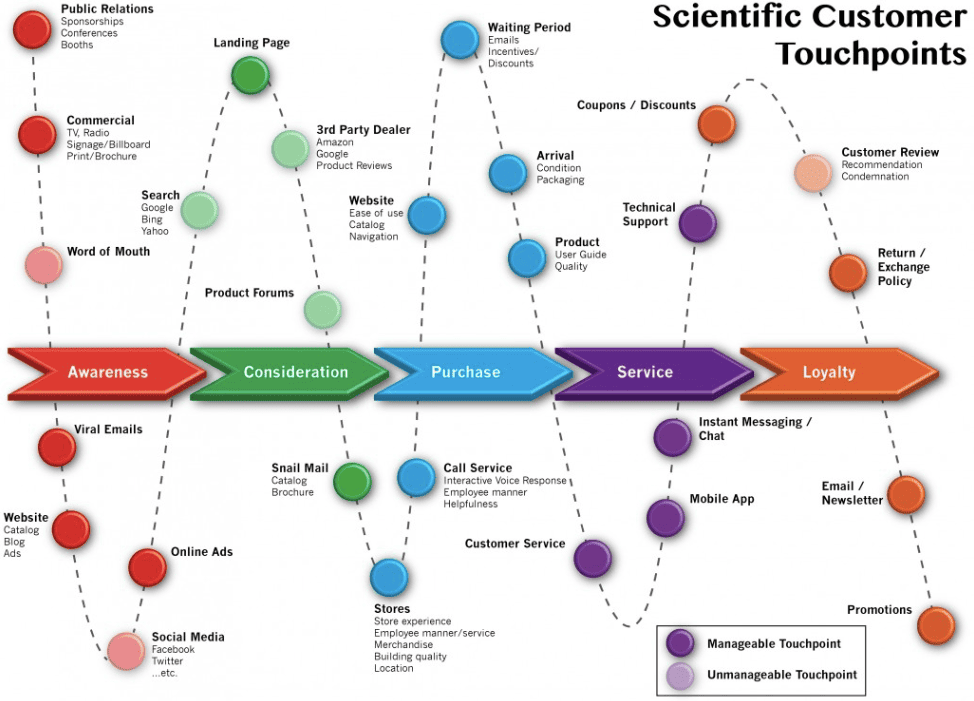
2. Identify customer pain points at each stage of the buyer’s journey
This step isn’t as simple as it sounds.
Why? Because companies often fail to judge the actual impact of certain issues. The graph below shows the difference between the actual customer experience and the brand’s idea of the customer experience in the B2C lead funnel.
A common theme here is that many companies underestimate their customers’ pain points. You can stay ahead of the competition by getting this basic step right.

So, do more market research and surveys on the pain points at each stage of your lead funnel. And, you’ll need to find a solution to each pain point that will drive them to the next stage.
For example, if you are having a lot of cart abandonment, then you can consider including a discount with the reminder email or SMS. If a low inventory is a common pain point, then an automated text and email notification can help bring prospects back to your website.
Mid-Funnel Marketing: A Succinct Guide [Definition, Strategies]
3. Identify marketing channels and publish quality content
Before starting this step, your buyer personas, key touchpoints, and major pain points at each stage should be clear to you.
Once you have this data in place, you’ll need to identify how to use different marketing channels, like email marketing, landing pages, social media, YouTube, and SMS or push notifications.
If you are marketing a SaaS company, the graph below highlights most of your main touchpoints and marketing channels:
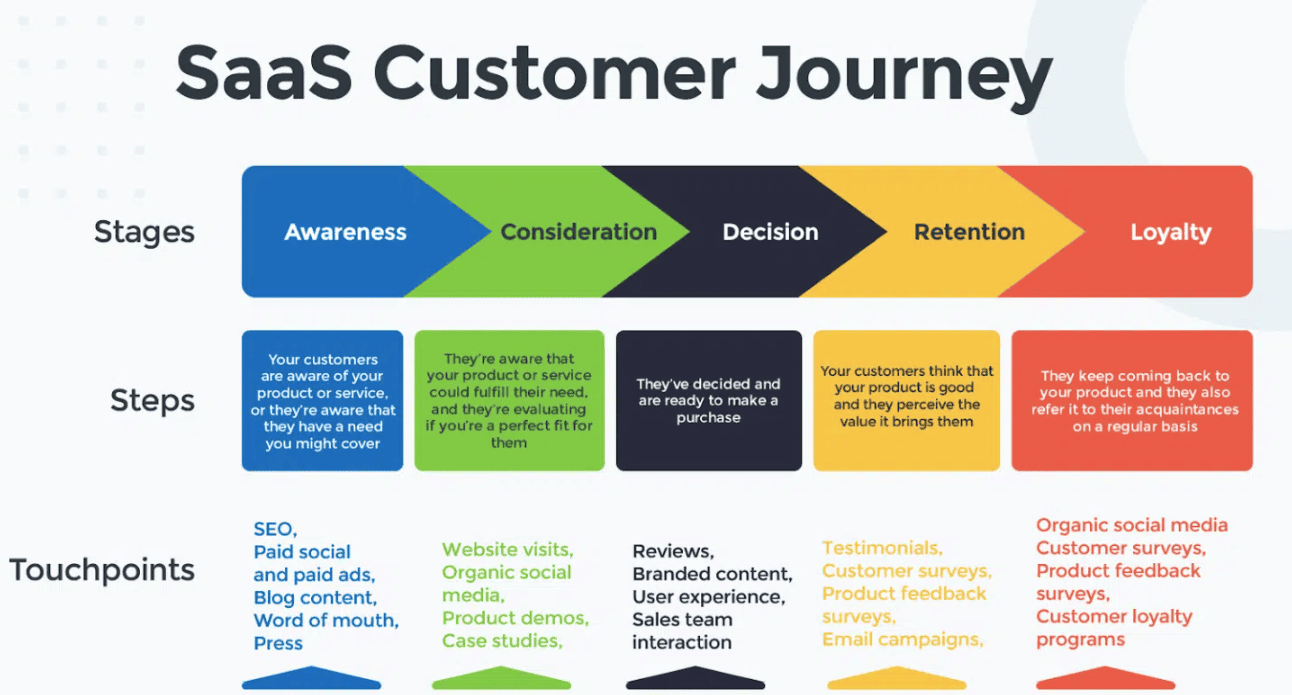
Now, you can set your marketing goals and key KPIs to measure for each stage of the lead funnel. Here are some content marketing KPIs for each stage of the lead generation funnel.
- Awareness stage: Focus on KPIs like organic traffic, paid traffic, ad frequency, a comprehensive SEO audit, website bounce rate, and pages per session.
- Interest stage: Measure KPIs like email open rates, app installs, and freebie downloads.
- Consideration stage: Focus on KPIs like email click-through rates, CTA clicks on landing pages, social media direct messages, and heatmaps to monitor user behavior.
- Action or Decision stage: Include KPIs like overall marketing ROI, customer lifetime value, and conversion rate.
4. Create a killer lead magnet and email drip campaigns
A lead magnet, as the name suggests, is a downloadable freebie that your prospects can get when they give you their email address. An irresistible lead magnet is a sure-shot way to generate new leads. Typically, video or short-form written lead magnets perform the best.
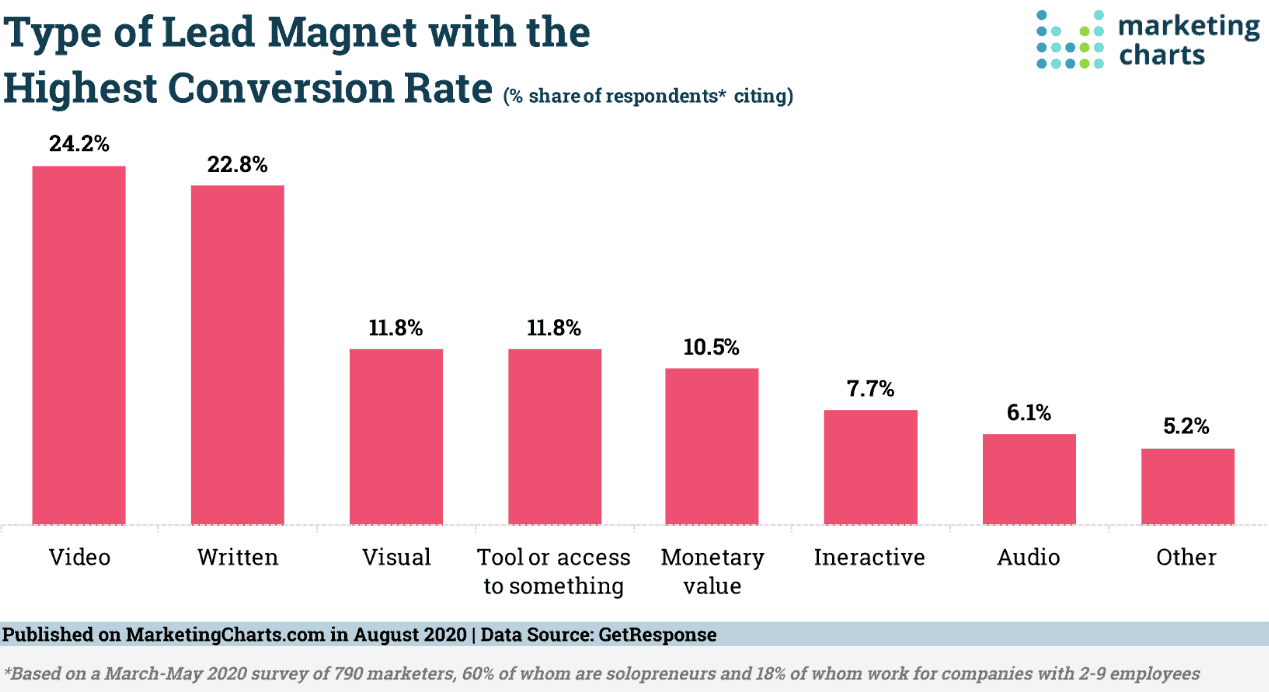
Here are some ideas for creating helpful lead magnets for your website.
- A checklist
- Video explainers
- Short digital guides or eBooks
- Templates
- Whitepapers
- Case studies
- Discounts or offers
- Interesting quizzes
- Bonus content or materials
- Workbooks or worksheets
Once you’ve decided on the content in your lead magnet, you’ll need to create a remarkable landing page and follow-up email templates to nurture your new leads.
5 Essential Marketing Funnel Basics Every Business Needs to Know
5. Add all your new leads to your CRM and qualify and segment your leads
You’ll need to gather all your contacts in one easy-to-access dashboard. As a rule of thumb, if you have over 100 contacts on your list, it’s time to graduate from using Excel and get a Customer Relationship Management (CRM) platform.
Lead scoring is assigning values to leads based on their behavior to identify the most qualified and viable leads.
Starting from a baseline of zero, you can add to the lead score whenever a lead performs a positive action, like signing up for your email list, adding items to the cart, and more. You can deduct points for actions like email bounces and prolonged periods of inactivity.
You’ll also need to segment your contact list based on customer profiles and preferences. This includes primary data like the contact’s age, gender, and location. You can further segment the list based on user behavior and interests.
Your marketing campaigns can be personalized based on this list. For example, not all your contacts may be interested in every offer you have. Or, you might want to roll out an offer to your contacts in the US alone. Without lead segmentation and predictive lead scoring, all this becomes a huge hassle.
6. Measure your KPIs and re-work strategies regularly
Once you’ve rolled out your marketing campaigns for every stage of the lead funnel, start measuring your key KPIs regularly. Measure KPIs for each marketing channel at every stage of the lead funnel.
This will give you a live snapshot of how your marketing campaigns are performing. Based on this data, you can refine your overall marketing strategy.
18 Powerful Marketing Strategies to Grow Business Faster
Simple Lead Funnel Tips to Double Your Sales
We’ve curated our top three expert tips on leveraging your lead funnel to double your sales. All three tips can be implemented quickly without denting your marketing budget.
1. Make an irresistible lead magnet by offering a quick, feasible solution
We’ve already talked about how a lead magnet can help you generate more leads. But, a lead magnet only works if it can actually solve a genuine problem faced by your leads.
For example, if a fitness company offers a 100-page guide on nutrition for bodybuilders, you might get a few takers. But, many contacts won’t have the time to read the whole book and then figure out how they can apply it in their life.
Instead of this guide, the company can consider offering a simple daily checklist of nutrients and micro-nutrients for bodybuilders.
In this case, the contact can immediately use the checklist in their daily life as soon as they download it. A catchy title like “The Ultimate Daily Nutrient Checklist from our Physicians” can work wonders too.
So, the bottom line is that you have to offer customers genuine value with your lead magnet while demanding minimal effort from them.
Here’s a great example from Peloton. This lead magnet will help you figure out the best workout for you based on simple questions. This reduces the time contacts will spend researching their ideal workout.
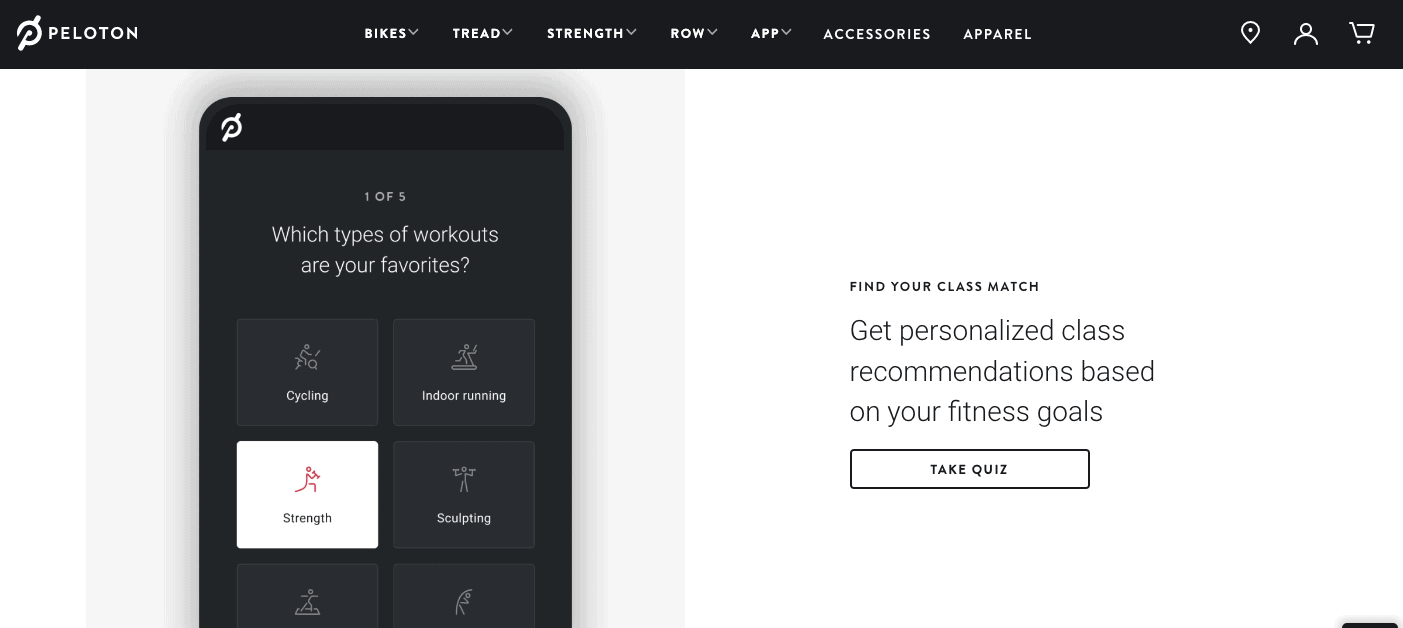
2. Boost conversion rates with customer segmentation and personalization
Using personalization techniques, you can send targeted messages to different contact list segments based on user activity and other relevant data points.
Email personalization is the most common. But, many companies are increasingly publishing personalized websites, content, landing pages, and so on.

Here are some personalization techniques to boost your conversion rates:
- Dynamic website content based on time of day
- Use dynamic personalization techniques for paid ad copy and design
- Website content is personalized based on the number of visits
- Personalized SMS or push notifications
12 Creative Small Business Marketing Ideas That Work
3. Use marketing automation and A/B tests
Marketing automation is the process of setting pre-defined workflows that can automatically complete repetitive tasks. An example of simple automation is deleting contacts who have unsubscribed from your CRM database. You can do a lot more with automated workflows.
Whether it’s scheduling social media posts or running a drip email campaign based on previous behavior — marketing automation can get it done for you.

You’ll also need to run regular A/B tests for your landing page and email elements. An A/B test (or split test) is used to compare two versions of the same component (like CTA buttons, or landing page banners) to determine which is more effective.
You can run A/B tests on the following:
- Website home page elements
- Landing pages
- Email copy, subject line, and CTA buttons
- Headlines, images, and text in ads
Combining the right marketing strategies, A/B testing, and marketing automation can work wonders in improving conversion rates.
Sales Pipeline Guide for Dummies (with relatable memes)
What are the Best Lead Generation Tools?
Here are our top picks in lead generation tools.
- HubSpot Marketing Hub: HubSpot’s Marketing and Sales Hubs can help you integrate your lead management and marketing efforts all in one dashboard. HubSpot’s excellent automation workflow capabilities, landing page builders, email and social media marketing integrations, and analytics make it a leader in the field.
- EngageBay: If you’re looking for a comprehensive lead generation, marketing, and CRM solution, EngageBay is your best bet. This platform can do it all, whether it’s predictive lead scoring or running email drip campaigns to nurture your leads.
- Hello Bar: This integrated messaging and email solution helps companies capture leads. Simply enter your URL to connect to Hello Bar. You’ll be able to send timed, targeted messages to prospects.
- Leadpages: Leadpages is a website builder equipped with a conversion toolkit. Their drag-and-drop landing page and website builder comes with real-time conversion optimization tips.
- OptinMonster: OptinMonster is a lead generation tool with a pop-up builder and marketing plugin. You can build a lead generation campaign from scratch and gather leads using pop-ups, alerts, sidebar opt-ins, and even gamified wheels.
Pros and Cons
| Lead Generation Tool | What’s Great | What’s Not So Great |
| HubSpot Marketing Hub |
|
|
| EngageBay |
|
|
| Hello Bar |
|
|
| Leadpages |
|
|
| OptinMonster |
|
|
Pricing plans at a glance
| HubSpot (Marketing Hub) | EngageBay (all-in-one) | Hello Bar | Leadpages | OptinMonster | |
| No. of Pricing Plans available | 3 (plus free trial) | 4 (including free plan) | 4 (including free plan) | 2 (no free plan) | 3 (no free plan) |
| Starter Plan | $50/month | $12.74/user/month | $29/month | $49/month | $19/month |
| Mid-Tier Plan | $890/month | $42.49/user/month | $49/month | N/A | $29/month |
| Premium Plan | $3,200/month | $84.99/user/month | $99/month | $99/month | $49/month |
| Free Trial | 14-Day Free Trial | Lifetime Free Plan, No Free Trial | Lifetime (5,000 views per month) | 14-Day Free Trial | No Free Trial |
Sales Pipeline Stages Every Business Should Use
Wrapping Up
As you’ve seen, the lead generation funnel is not exactly child’s play. There’s a lot that goes into defining the lead stages and touchpoints for your company.
Your lead funnel is the foundation for your marketing strategy. After all, all your content and messaging depend on the lead funnel stage.
We hope that you found something helpful in this article. Please share it with your colleagues and friends if you liked this blog post.
Also, if you need a lead management and CRM tool, try EngageBay for free.
